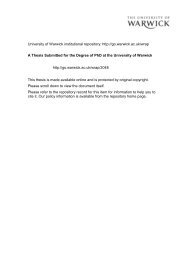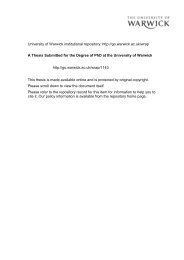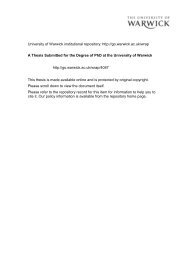From Page to Screen - WRAP: Warwick Research Archive Portal ...
From Page to Screen - WRAP: Warwick Research Archive Portal ...
From Page to Screen - WRAP: Warwick Research Archive Portal ...
You also want an ePaper? Increase the reach of your titles
YUMPU automatically turns print PDFs into web optimized ePapers that Google loves.
have shadows added.<br />
These possibilities are, however, not always welcomed. In a Newsweek article entitled"A<br />
Font a Day Keeps My Muse Away?", journalist Jerry Adler expresses a strong dislike of<br />
the visualisation oflanguage through word-processors, which leads <strong>to</strong> a situation where he<br />
has <strong>to</strong> choose from "dozens of fonts in a mind-boggling array of sizes, from a cornucopia<br />
ofborder designs and an array ofterminal curlicues, darts, starbursts and fleurs-de-lis that<br />
would look presumptuous on the letterhead of an emperor". He calls himself an<br />
"extremist" on the subject of verbal vs. graphic representation, a puritan who wants <strong>to</strong><br />
keep the two separated, not go along with theories that want <strong>to</strong> blur the border between<br />
two forms ofrepresentation and electronic writing that put the theories in<strong>to</strong> practice. He<br />
wants <strong>to</strong> use words <strong>to</strong> describe what he has <strong>to</strong> say, without having <strong>to</strong> worry about what<br />
they look like on the page, because "I'm a writer, that's what I do."<br />
Some might agree, but the majority of users ofword-processors enjoy the greater power<br />
that electronic writing undoubtedly allows over the visual appearance of the text - and<br />
with high-quality printers now affordable and direct publishing of electronic text on the<br />
internet more and more popular, authors at times have complete control over the<br />
presentation, the peritext, of their writing. So far printing technology has led <strong>to</strong> an<br />
increasing separation between the author and his/her text, a consequence of electronic<br />
writing is <strong>to</strong> bring the two now closer <strong>to</strong>gether again.<br />
Before Gutenberg's invention of the movable-letter printing press in 1434 when the<br />
mass-reproduction of identical books became possible, the majority of books were<br />
handwritten. They were done with amazing skill, often with ornate illustrations and<br />
elaborate initial letters. Their crea<strong>to</strong>rs were, as well as authors or copyists, artists at the<br />
same time, responsible not only for the contents, but also for the appearance of their<br />
texts. Gutenberg's invention changed this and the author's job (writing and preparing<br />
the textual side) and the typographer/printer's(working on the visual side of a text)<br />
became two separate activities. Writers handed over the responsibility fat the layout and<br />
look of their text <strong>to</strong> the printer. Typography was no longer considered an integral part of<br />
67 Jerry Adler, "A Font a Day Keeps my Muse Away", Newsweek, 24 Oc<strong>to</strong>ber 1994. p·49·<br />
Chapter 4 - page 151





